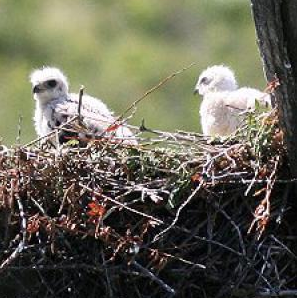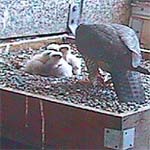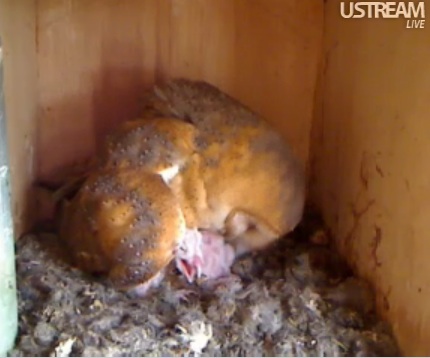
Nest cam photo by Moosalope from about.com
One of my favorite obsessions in recent springs is watching online nest cams. This week, in between packing and then moving, I consoled myself by stealing a few moments to watch miniature fluffy dinosaurs shuffling and sleeping and eating while their parents brooded and brought food and mated right on camera. It’s voyeurism pure and simple, but in a good way. If you’re stuck indoors you can still birdwatch—up close and personal.
I got hooked on nest cams back in 2005 when the peregrine falcons named Gracie and George nested  on the 33rd floor of an office building in downtown San Francisco and raised their family before thousands of viewers. Office workers gathered for lunch on the Drumm Street Bridge to keep an eye on the skies as young eyases (“I-us-es”) took flight.
on the 33rd floor of an office building in downtown San Francisco and raised their family before thousands of viewers. Office workers gathered for lunch on the Drumm Street Bridge to keep an eye on the skies as young eyases (“I-us-es”) took flight.
And how they flew! Falcons are the fastest of the birds; in their hunting dives, called “stoops,” they can reach speeds of two hundred miles per hour. Three of the eyases that spring fledged safely while the fourth flew straight into one of the many plate-glass windows in the financial district. The ratio is not unusual; birds are extremely vulnerable to windows.
This year a different pair is nesting in the same box. As of today the peregrines are still incubating, but the eggs are due to hatch this week, and you can watch all the action on the Santa Cruz Predatory Bird Research Group site. If you tune in, prepare to spend more than a few minutes getting lost in baby-bird world.
Peregrines were at the brink of extinction (thin, fragile eggs due to DDT), and only years of dedicated peregrine watching and egg incubating by ornithologists around the country saved them. For a laugh-out-loud essay involving peregrines and bird scientists, look up David James Duncan’s “Cherish This Ecstasy,” from The Sun (2008), reprinted in The Best American Essays 2009, edited by Mary Oliver. His image of an ornithologist donning a mating hat to capture peregrine sperm is way past funny. And what he does with this image in the essay will take your breath away.
 But my favorite nest camera this year—and apparently the fave of more than 10,000 other people—is in a backyard nest box in southern California hosting a barn owl pair and four (so far) owlets. Molly (mom) sits and shifts and listens and senses, catching a few winks of sleep in between restless-baby syndrome. McGee (dad) brings a mouse or opossum or rabbit, sometimes stealing a few moments of nooky in his nightly visits. All right in front of your eyes. It’s voyeurism of the best kind. The birding kind.
But my favorite nest camera this year—and apparently the fave of more than 10,000 other people—is in a backyard nest box in southern California hosting a barn owl pair and four (so far) owlets. Molly (mom) sits and shifts and listens and senses, catching a few winks of sleep in between restless-baby syndrome. McGee (dad) brings a mouse or opossum or rabbit, sometimes stealing a few moments of nooky in his nightly visits. All right in front of your eyes. It’s voyeurism of the best kind. The birding kind.